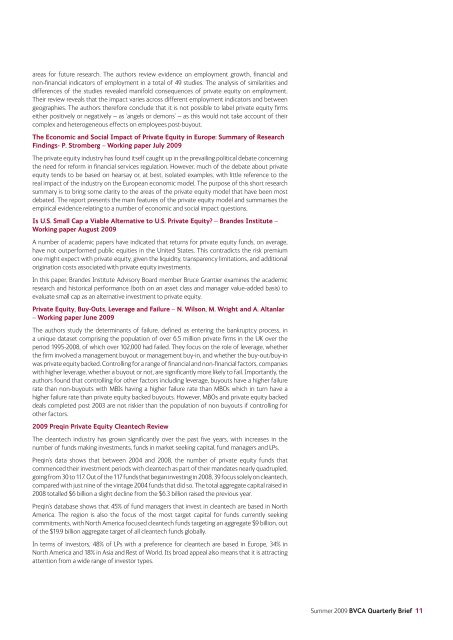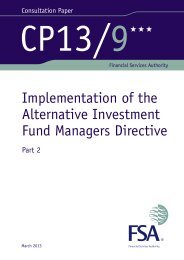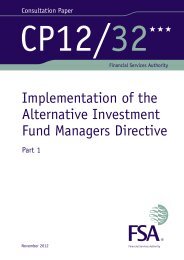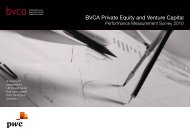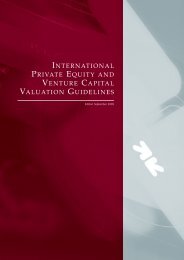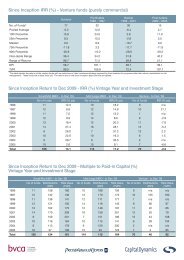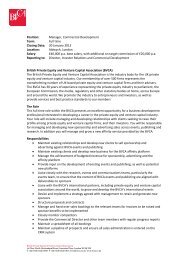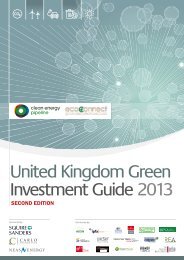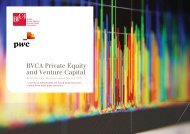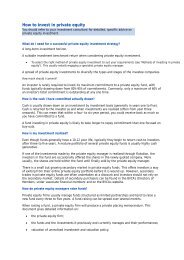What's inside - BVCA admin
What's inside - BVCA admin
What's inside - BVCA admin
You also want an ePaper? Increase the reach of your titles
YUMPU automatically turns print PDFs into web optimized ePapers that Google loves.
areas for future research. The authors review evidence on employment growth, financial and<br />
non-financial indicators of employment in a total of 49 studies. The analysis of similarities and<br />
differences of the studies revealed manifold consequences of private equity on employment.<br />
Their review reveals that the impact varies across different employment indicators and between<br />
geographies. The authors therefore conclude that it is not possible to label private equity firms<br />
either positively or negatively – as ‘angels or demons’ – as this would not take account of their<br />
complex and heterogeneous effects on employees post-buyout.<br />
The Economic and Social Impact of Private Equity in Europe: Summary of Research<br />
Findings- P. Stromberg – Working paper July 2009<br />
The private equity industry has found itself caught up in the prevailing political debate concerning<br />
the need for reform in financial services regulation. However, much of the debate about private<br />
equity tends to be based on hearsay or, at best, isolated examples, with little reference to the<br />
real impact of the industry on the European economic model. The purpose of this short research<br />
summary is to bring some clarity to the areas of the private equity model that have been most<br />
debated. The report presents the main features of the private equity model and summarises the<br />
empirical evidence relating to a number of economic and social impact questions.<br />
Is U.S. Small Cap a Viable Alternative to U.S. Private Equity? – Brandes Institute –<br />
Working paper August 2009<br />
A number of academic papers have indicated that returns for private equity funds, on average,<br />
have not outperformed public equities in the United States. This contradicts the risk premium<br />
one might expect with private equity, given the liquidity, transparency limitations, and additional<br />
origination costs associated with private equity investments.<br />
In this paper, Brandes Institute Advisory Board member Bruce Grantier examines the academic<br />
research and historical performance (both on an asset class and manager value-added basis) to<br />
evaluate small cap as an alternative investment to private equity.<br />
Private Equity, Buy-Outs, Leverage and Failure – N. Wilson, M. Wright and A. Altanlar<br />
– Working paper June 2009<br />
The authors study the determinants of failure, defined as entering the bankruptcy process, in<br />
a unique dataset comprising the population of over 6.5 million private firms in the UK over the<br />
period 1995-2008, of which over 102,000 had failed. They focus on the role of leverage, whether<br />
the firm involved a management buyout or management buy-in, and whether the buy-out/buy-in<br />
was private equity backed. Controlling for a range of financial and non-financial factors, companies<br />
with higher leverage, whether a buyout or not, are significantly more likely to fail. Importantly, the<br />
authors found that controlling for other factors including leverage, buyouts have a higher failure<br />
rate than non-buyouts with MBIs having a higher failure rate than MBOs which in turn have a<br />
higher failure rate than private equity backed buyouts. However, MBOs and private equity backed<br />
deals completed post 2003 are not riskier than the population of non buyouts if controlling for<br />
other factors.<br />
2009 Preqin Private Equity Cleantech Review<br />
The cleantech industry has grown significantly over the past five years, with increases in the<br />
number of funds making investments, funds in market seeking capital, fund managers and LPs.<br />
Preqin’s data shows that between 2004 and 2008, the number of private equity funds that<br />
commenced their investment periods with cleantech as part of their mandates nearly quadrupled,<br />
going from 30 to 117. Out of the 117 funds that began investing in 2008, 39 focus solely on cleantech,<br />
compared with just nine of the vintage 2004 funds that did so. The total aggregate capital raised in<br />
2008 totalled $6 billion a slight decline from the $6.3 billion raised the previous year.<br />
Preqin’s database shows that 45% of fund managers that invest in cleantech are based in North<br />
America. The region is also the focus of the most target capital for funds currently seeking<br />
commitments, with North America focused cleantech funds targeting an aggregate $9 billion, out<br />
of the $19.9 billion aggregate target of all cleantech funds globally.<br />
In terms of investors, 48% of LPs with a preference for cleantech are based in Europe, 34% in<br />
North America and 18% in Asia and Rest of World. Its broad appeal also means that it is attracting<br />
attention from a wide range of investor types.<br />
Summer 2009 <strong>BVCA</strong> Quarterly Brief 11


